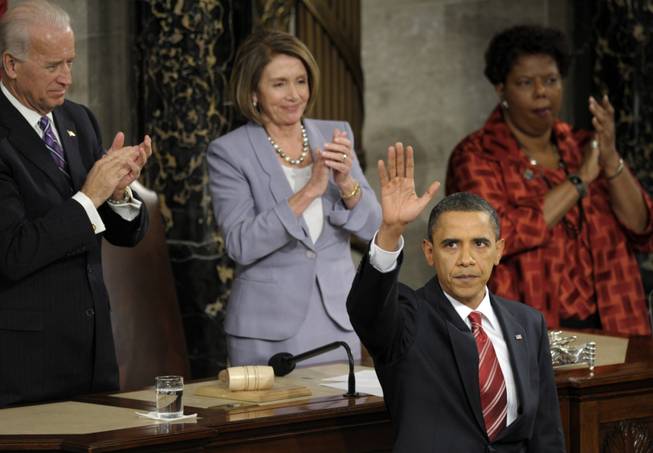
Susan Walsh / AP
President Barack Obama waves after delivering his State of the Union address on Capitol Hill in Washington on Wednesday, Jan. 27, 2010. Vice President Joe Biden and House Speaker Nancy Pelosi applaud.
Friday, Jan. 14, 2011 | 2:05 a.m.
There are many traditions associated with the president’s annual State of the Union address, from the parade of congressional glitterati to the well-rehearsal rebuttals to the drinking games television audiences play with the commander-in-chief’s go-to buzzwords.
But this year, Democrats are pushing to turn one of the most longstanding traditions on its head.
They want to end the 200-plus-year practice of lawmakers sitting by party when they receive the president’s remarks.
Sen. Mark Udall of Colorado, who proposed the change, pointed out there’s nothing in the nation’s founding documents that suggests lawmakers must, or even should, sit separated by political persuasion when the president addresses the body.
“Perhaps by sitting together for one night we will begin to rekindle that common spark that brought us here from 50 different states and widely diverging backgrounds to serve the public good,” he said in a letter to his colleagues in the House and Senate.
The suggestion has been received warmly by Democratic leaders.
“We need to look for more ways to be bipartisan,” said Senate Majority Leader Harry Reid. “It’s important for our country that we all stand together as Americans and this could be one way to demonstrate that.”
Washington has been backing away from its own displays of partisanship in the last few days as lawmakers grapple with an attack made on one of their own, Arizona Congresswoman Gabrielle Giffords, who was shot in the head Saturday when a gunman opened fire on a town hall meeting she was holding in Tucson, killing six and injuring 13 others. She is recovering.
“A gesture like this won’t make partisanship disappear, nor should it,” said House Minority Whip Steny Hoyer. “But this gesture...should help end the political theater of repeatedly seeing one side of the aisle rise in applause, as the other sits still.”
Republicans haven’t objected and are indicating they will be perfectly happy to go along with the plan.
But in the end, this may just turn out to be a test of how very informal — and potentially endemic — the divisions in Congress are.
Lawmakers are not assigned seats for the State of the Union address, save for House Speaker John Boehner and Senate President Joe Biden — yes, that’s the VP’s official job, remember — who will sit behind the president as he delivers his speech, and the other party leaders who will accompany the president in the traditional procession through the House chamber: they get seats in the front.
That means there may be a fair amount of self-segregation.


Join the Discussion:
Check this out for a full explanation of our conversion to the LiveFyre commenting system and instructions on how to sign up for an account.
Full comments policy